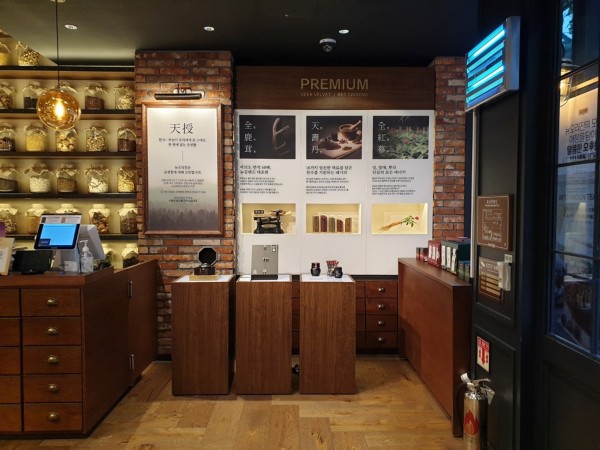Oct 18, 2021
Velvet companies and Deer Industry NZ (DINZ) are reporting strong underlying demand for NZ deer velvet antler in major Asian markets. The season begins in October each year and runs through to late January.
Velvet is one of the two of the most highly valued ingredients, along with red ginseng, in traditional Chinese medicine. NZ velvet is also being increasingly recognised for its superior quality by major health food companies in Korea, for use in high profile branded products.

A NZ velvet product display at a New Origin health food store in Seoul, South Korea
DINZ markets manager Rhys Griffiths says his optimism for the season is tempered by risks outside the industry’s control, like potential shipping delays and regulatory issues in major markets.
“Shipping delays and port shutdowns last season were costly and disruptive for Chinese importers, so there’s still some nervousness around. At the moment the coast is clear, so buyers are wanting to move velvet from the farm and onto ships as quickly as possible,” he says.
Shaun Stevenson, operations and marketing manager of CK Import-Export, one the country’s largest velvet exporters, told the annual meeting of NZDFA branch chairs last week that there is no downward pressure on the market this season.
“The market is in good shape and buying has started at a stronger level than where it ended last season. The main challenges are logistics – shortage of container space and the potential for wharf shutdowns. We are doing everything we can to mitigate those risks.”
PGG Wrightson velvet manager Tony Cochrane said the market is looking really good. “There is no stock in the system and the countries we are exporting to have enjoyed greater GDP growth than other countries have internationally.”
Looking ahead, Cochrane sees massive potential for sales of NZ velvet to China, especially for use in health food products. He says the industry’s new web-based tag and track system, VelTrak, is going to provide health food companies there with the traceability and assured provenance they need to protect the reputation of their brands.
Ross Chambers, general manager of Provelco, a farmer co-operative, says sales to Korean health food companies have been the big success story in recent years. There’s also the potential to get velvet registered in South Korea as a healthy functional food – a food with proven health benefits, which would lift demand up to another level.
More immediate growth prospects are China, Taiwan and other Asian markets – especially those with significant ethnic Chinese populations.
Griffiths says DINZ is working with the three major velvet exporters through the China Velvet Coalition to establish a bridgehead for NZ velvet sales to major health food companies in China. He expects a formal agreement will be signed with one or more such companies in the near future.
In the meantime DINZ is busy in South Korea with market support activities. It has formal agreements with eight of the more than 30 health food companies that market products promoted as being based on NZ velvet.
“We are running joint promotions over Chuseok, Korean Thanksgiving, one of the main gift-giving periods there.”
DINZ also offers scholarships to university students studying to become oriental medicine doctors.
|
Background information Every spring, stags (male deer) grow new antlers which eventually harden and become bone. While they are growing they are covered in fine hairs and are soft to touch, hence the name velvet, which applies to the whole antler – not just the skin. Velvet antlers are humanely removed from stags by veterinarians or certified farmers in late spring, when the bioactive content of the antlers is at its peak. The removal of velvet antler is controlled by the Animal Welfare Act and the Animal Products Act. There are also strict Codes of Welfare and regulations applying to velvet removal. Velvet removal can only be carried out by a registered veterinarian or by a trained and certified farmer who has passed a written theory exam and a practical assessment by an independent veterinarian. An anaesthetic must be used, so the stag feels no pain. Any distress must be minimised. Certified farmer velvetters are assessed each year by a supervising veterinarian. In addition, random independent audits of both certified velvetters and veterinarians are carried out each year, to monitor compliance and ensure the integrity of the programme. Deer velvet is highly valued by oriental medicine. In recent years there has been rapid growth in demand for NZ velvet for natural health products to combat fatigue and to boost immunity. The top-selling velvet-based product is for busy executives to give them an energy boost and clearer focus at work. The value of velvet as a health food ingredient is supported by a growing body of research, particularly within Asia. Stags kept for velvet production are often farmed for 10 years or more in an extensive pastoral environment. They are managed to ensure they are healthy, well-fed and to minimise fighting during the mating season, known as the roar. |
For more information, contact:
Markets: Rhys Griffiths, Markets Manager, DINZ, Tel 021 506 647
Deer welfare: Dr Rob Gregory, General Manager Quality Assurance, DINZ, Tel 027 246 5606

